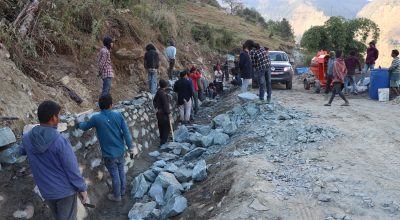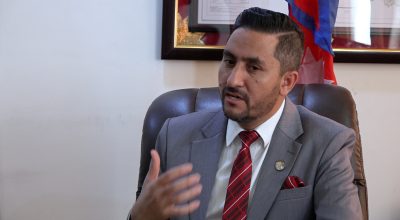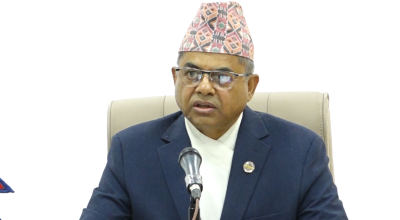
-Narayan Prasad Ghimire/RSS
KATHMANDU: As we Nepalis pride on the Mt Sagarmatha or Everest, the highest peak of the world, it is worrisome to see the snow-clad peaks getting bare for some years. Our pride on richness in geographical diversity is again greeted by the biting fact that Nepal is listed as the fourth most vulnerable country in terms of climate change. Nepal’s vulnerability is alarming though it has a meagre role on global emission of GHGs.
It has been long the Kathmandu Valley stopped witnessing morning fog and frost in winter. Depletion of groundwater is already a severe problem, thereby rendering several ancient stone spouts run dry. The rivers too are turning into sludge.
Moreover, as I sit before the computer for this write-up, the news stories are coming about the havoc wreaked by post-monsoon rainfall on near-harvest paddy in different parts of the country. Huge rainfall was recorded yesterday and day before yesterday. Media has brought several other stories of climate crisis- water resources gone dry, cloudbursts causing landslides and floods, loss of weeds, emergence of invasive plants etc.
The change in pattern of rainfall has severely impacted livelihood. Furthermore, damage to property and loss of lives are likely to increase.
A recent example of extreme weather event in Nepal- Melamchi floods- caused by the land slide, which was triggered by the erratic rainfall, cloudburst. Environmental expert Dr Ngamindra Dahal said the cloudburst causing Melamchi devastation was due to the shift of monsoon to higher altitude. It was almost unpredicted weather event. The extreme weather at higher altitude is obviously more devastating because it covers huge area downstream, he added.
Climate Crisis
Although the climate naturally changes over time, the alarming severity, speed and frequency of unpredictable events befalling us in recent years in the country and abroad has forced everyone to term climate change a ‘climate crisis’. The once-in-lifetime events are turning into decadal events and they are likely to recur over shorter period in future. It is all due to climate crises. The Melamchi devastation in Nepal is a recent example of once-in-lifetime event.
The melting of snow and rising sea level with global warming and other extreme weather events have been commonplace. The forest fire in Australia and western belt of America for long time and floods in Europe are other significant climate crises which have spurred huge debate on climate. Actually, every country is at the receiving end of climate crisis. Indonesia and the Maldives are worrying over their cities getting sunk day by day.
The rise of temperature was projected in Nepal too. In a website of the World Resource Institute, expert on water resource, Ajay Dixit, brings a research reference which warns of increase in temperature in Nepal’s hilly region. He mentioned, “In 2009, a modeling exercise conducted by team of Nepali, American, British, Pakistani and Bangladeshi experts (NCVST, 2009) using the emissions scenarios in the IPCC’s special report (2007) found that the temperature will indeed increase in the mid-hills and that this region is likely to grow more arid in the non-monsoon seasons. It also suggested that precipitation is likely to be more uncertain and that storm intensity will increase.”
Stage Set for COP26
With this and several other developments on climate crisis in the background, entire world’s attention is now on COP26. The global climate summit being held at Glasgow City of Scotland, the UK this November is gathering world leaders, which is being keenly followed by many. From the least developed countries (LDCs) to developing ones and developed economies, the event is much awaited to see what new commitments would be made and promises made after historic Paris Agreement 2015 fulfilled. In addition to the States, numerous civil society organizations, climate activists, researchers, environmentalists, conservationists, nature conservationists, protestors from across the globe are exerting pressure on the world leaders to make meaningful commitments and materialize the efforts to avoid climate crisis.
In addition to the efforts the LDCs make on their individual and collective levels relating to climate crisis and adaptation, they need to continue prodding the big countries to check whether they are committed to achieve net-zero global emissions and how they are conducting activities to materialize the goal. On the other hand, the biggest emitters are equally responsible to extend support to the LDCs and developing countries to empower them for coping up climate crisis.
G20 countries made aware on Paris Agreement goal
In this connection, the recent (October 11) LDC Ministerial Meeting noted with grave concern that the current new and revised Nationally Determined Contributions (NDCs) do not put the world on track to the 1.5°C temperature goal of the Paris Agreement. Similarly, it also called upon the G20 countries to ‘further enhance their NDCs in line with 1.5°C pathways and consistent with their responsibilities and capabilities to undertake climate action, in order to reduce the emissions gap to 1.5°C; and further call for Parties to urgently submit long term low emission development strategies (LTS) aiming to achieve net-zero global emissions by 2050.’
The LDCs seek more effective roles from the big countries to avoid climate crisis. Limiting global temperature rise within 1.5°C compared to pre-industrial period is one of the most important goals of Paris Agreement, which is a binding accord.
Earlier, the wakeup call was made even by the IPCC report in September. Following the IPCC report, UN Secretary-General Antonio Guterres shared the IPCC report on Twitter on Sept 7 and warned, “The planet is dangerously close to reaching the internationally agreed threshold of 1.5.C global warming. We must act decisively now to avert a climate catastrophe. There is no time for delay and no room for excuses.”
Moreover, in a video message to the Leaders Summit of the UN Biodiversity Conference held recently- on October 11, UN Secretary-General Guterres urged the leaders to lay the foundation for permanent peace agreement together with COP 26 on climate. “By 2030, we must reverse our trajectory and start to build the world we want,” he underscored.
Announcements by Advance Economies
The role, pledges and action by the super powers are counted much in the endeavour to cope up climate crisis. The views and stand of industrialized and advanced economies are therefore noted well. In this connection, Chinese President Xi Jinping said in the recent UNGA that his country will stop funding coal projects overseas, reducing a key source of pollution behind climate change. Xi’s announcement was welcomed by the UN Climate Envoy John Kerry. Envoy Kerry said he was “absolutely delighted” by Xi Jinping’s announcement that China would not build any more coal-fired power plants abroad.
Similarly, in the same event, the additional climate finance to the developing country was announced by another advance economy, the US. US President Joe Biden announced to augment US financial contribution to climate change to 11.4 billion USD a year.
At the 76th session of the UNGA, the advance economies were urged to take a lead in cutting down carbon emission.
In the event, Nepal’s Foreign Minister Dr Narayan Khadka observed that ‘climate change has become existential threat to humanity.’ He also made aware the global leaders that “Nepal is at the sharp end of climate change despite its negligible share in greenhouse gas emissions. On our part, we reiterate our commitment to delivering climate-resilient development pathways by 2030 and net-zero emissions by 2050.”
Nepal has been relentlessly making aware and showing concern in the regional and global community on the risks it has been facing owing to climate change. The issues of climate change are underscored well on global platforms as in UNGA. The disproportional effect of climate change in Nepal despite being a global problem, and despite its negligible emission is reiterated.
Unique Initiatives
Drawing world’s attention on environmental degradation and climate change effects with interesting and impressive moves have continued for long. For some years, even the rights of nature- rivers, hills, lakes, forest- have emerged in different parts of the world.
In Nepal, the Madhav Kumar Nepal-led government had held a cabinet meeting at Kalapatthar, basecamp of the Mt Everest, in December 2009. The historic meeting held above 5,000 meters had issued a 10-point ‘Everest Declaration’, drawing global attention on rising temperature and melting mountains. Even the international media had given top priority to this event.
Then, the CNN had reported the event giving title, “Everest hosts Nepal cabinet meeting”, while Reuters’ title was “Nepal cabinet meets at Everest to send climate message”.
In the news the CNN had quoted the PM Nepal, saying, “The earth is our common abode. To save the earth the biggest sacrifice is needed from nations producing large amounts of carbon.” The meeting was held before the climate summit in Copenhagen.
Similarly, Maldives, one of the island countries suffering much due to rising sea levels, had conducted the Cabinet meeting below the sea the same year. In October 2009, the government led by President Mohamed Nasheed held the underwater Cabinet meeting, giving a message that the country was sinking with rising sea level caused by global warming.
Since these unique events, tens of hundreds of events focusing climate change effects/impacts have been held across the globe. Several national efforts are made on climate change in Nepal including the formulation of national policy on climate change, policy on adaption at local level, creation of dedicated division in the Ministry of Environment and lately the initiatives as per Paris Agreement like Nationally Determined Contribution (NDC), and Second National Communication etc.
A high level delegation led by Prime Minister Sher Bahadur Deuba from Nepal is also taking part in the landmark COP26 beginning in the UK two weeks later.
Constitutional right to nature
Another interesting development emerged in the South America first and then spread to other countries. It was 2008 that Ecuador became the first country to constitutionally guarantee the rights to nature. The new trend gradually replicated in Bolivia, Mexico, Colombia, New Zealand etc. A recent one in the neighbourhood that even SAARC member state Bangladesh gave legal rights to river. The e-version of the Daily Star mentioned: “In February 2019, the High Court Division (HCD) of the Supreme Court of Bangladesh delivered a landmark decision granting all rivers with ‘legal personhood,’ declaring all rivers in Bangladesh to have legal protection. The core outcome of the verdict is 17 major directives for addressing river pollution and illegal riverbank development (‘encroachment’).”
Pay Heed to Vulnerable, LDCs
There are several countries like Nepal still in the least developed category characterized with multidimensional poverty, paucity and backwardness. As a result, the vulnerable groups would be further jeopardized by the hostility posed by climate crises. Therefore, the LDCs deserve assistance from the advance economies for mitigation and adaption measures. However, simply extending support would not suffice because carbon emission must be cut down by the largest polluters.
To this regard, Dr Dahal said, “Only verbal commitment does not ensure justice to the most vulnerable countries. Most important is how the promises are put in practice so that vulnerable ones would not be pushed to further climate crises.” In case of Nepal, he pointed out the need of further financial to technical supports to promote the mitigation and adaptation, and to implement national targets on climate change.
Now, the climate change is not a concern limited to environmentalist, conservationist, climate activists, nature rights defenders, a government, a state, but the concern of the entire globe, the world population. Time has come for both the small and big, developing and developed, island and others to work together to redefine human relations to nature, the mother Earth. Does the COP26 become a platform for the world leaders to make the world a livable place for all humanity?
The studies on the environment crisis have clearly shown that the industrialization had the cost on pristine nature. The exhaustion of nature continued unabated for the industrialization. And, the industrialized countries made significant progress. Now, emerged the climate crisis- pushing every human on earth at receiving end. Now, can’t it be utilized as the best time to redefine the roles that exacerbated the environmental degradation, and the time to avoid further crisis with concerted efforts?
About the coming COP26, the Reuters quotes environment and climate activist Greta Thunberg, “Success at upcoming COP26 would be possible only if world leaders honestly admit that their action is not living up to their words.”














